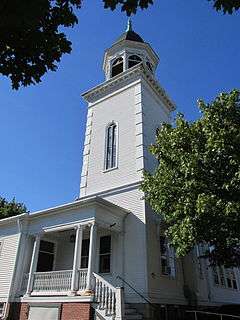Pawtuxet Village
|
Pawtuxet Village Historic District | |
|
Pawtuxet Baptist Church | |
  | |
| Location | Bounded roughly by Bayside, S. Atlantic, and Ocean Aves., Pawtuxet and Providence Rivers, and Post Rd., Cranston, Rhode Island |
|---|---|
| Coordinates | 41°45′49″N 71°23′27″W / 41.76361°N 71.39083°WCoordinates: 41°45′49″N 71°23′27″W / 41.76361°N 71.39083°W |
| Built | 1638 |
| Architect | Multiple |
| Architectural style | Late Victorian |
| NRHP Reference # | 73000050[1] |
| Added to NRHP | April 24, 1973 |
Pawtuxet Village is a section of the New England cities of Warwick and Cranston, Rhode Island. It is located at the point where the Pawtuxet River flows into the Providence River and Narragansett Bay.
History
Pawtuxet means "Little Falls" in the native language, and this area was originally occupied by the members of the Sononoce Pawtuxet tribe, part of the larger Narragansett Indian nation, who used the area as a feasting ground. In 1638, Rhode Island founder Roger Williams purchased the property extending south from Providence to the Pawtuxet River. Shortly thereafter his followers; William Arnold, William Harris, William Carpenter, and Zachariah Rhodes, settled along the fertile meadows of the Pawtuxet. Meanwhile, Samuel Gorton, the founder of Warwick, purchased the land south of the Pawtuxet River.[2]
Early 18th century inhabitants took advantage of the power of the Pawtuxet River by constructing various mills, and took advantage of its excellent harbor by building one of America's premiere shipping ports. The Pawtuxet Village Historic District boasts dozens of preserved Colonial structures among its scenic blend of homes and buildings. The mouth of the Pawtuxet River was a strategic location to settle, and gave boats a safe harbor and the village considerable importance in the triangular trade of the day, and shipyards for the coastal and West Indies trade were located here.
It was here in 1772 where Rhode Island patriots took the first organized military action towards independence by attacking and burning the hated British revenue schooner, HMS Gaspée. This was America's "First Blow for Freedom" that led directly to the establishment of permanent Committees of Correspondence, unifying the individual colonies, and starting the process of the American Revolution. The cities of Cranston and Warwick celebrate this historic role of Pawtuxet Village by playing host to the annual Gaspee Days Parade each June.
During the early 19th century Christopher and William Rhodes formed the textile manufacturing firm which controlled the prosperity and swayed the destiny of Pawtuxet for more than half a century. It changed from a shipping port to a mill village with textile mills at either end of the Pawtuxet Falls. Pawtuxet shops and businesses of the 19th century may be seen on old advertising maps from about 1862-1870.[3]
In the late 19th century, the Rhodes family developed one of Rhode Island's top attractions, the famous Rhodes-on-the-Pawtuxet casino, dance hall, and canoe center. Trolley lines from Providence carried vast numbers to the Pawtuxet area for a day of family fun and relaxation. Area merchants prospered, and to this day, Pawtuxet Village remains a central focal point in the lives of the surrounding population.[4]
Notable residents
- Elisha Hunt Rhodes (1842-1917), soldier of the 2nd Rhode Island Volunteers and diarist of the Civil War
See also
- The Experiment, a horse powered boat first tested here.
- National Register of Historic Places listings in Providence County, Rhode Island
- National Register of Historic Places listings in Kent County, Rhode Island
References
- ↑ National Park Service (2009-03-13). "National Register Information System". National Register of Historic Places. National Park Service.
- ↑ The history of Warwick, Rhode Island, from its settlement in 1642. Oliver Payson Fuller (1875).
- ↑ http://pawtuxet.com/historichomes.htm
- ↑ Pawtuxet, Rhode Island By Donald A. D'Amato & Henry A. L. Brown (1997)
